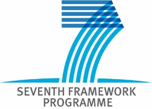News and Events
Jul 13 2016ImagineS final review held on 7th July 2016 in Brussels
The meeting has a twofold objective: 1) report the work performed during the last period of the project; 2) summarize the overall project achievements and compare them with the initial objectives and expected impacts.
ImagineS partners have presented the results obtained during the last 18 months which led to:
- the ground measurements and the resulting up-scaled maps of LAI, FAPAR, FCover collected during the 2015 and 2016 field campaigns
- the time series of Landsat-8 LAI, FAPAR, FCover maps over 8 regional sites as demonstration of the use of Sentinel-2 data
- the time series of LDAS output (LAI, root and surface soil moisture, evapotranspiration, NEE, GPP, AGB) and associated anomalies, useful as drought indicators, over cropland and grassland sites in France, Hungary and all around the world.
- the crop maps (pre-seasonal crop map, crop group map, crop type maps along the season) above the Free State Province of South Africa as a demonstration of the synergetic use of microwave Sentinel-1, optical Sentinel-2 and high frequency Sentinel-3 data
- the development of original method to fuse decametric and high temporal frequency hectometric biophysical products to generate dekadal decametric products
- the extension of the LDAS-France to the Euro-Mediterranean basin
ImagineS coordinator summed up the overall project achievements and explained how they are exploited:
- in the
Copernicus Global Land Service:
- the GEOV3 and the albedo processing chains are operated in the CGLS to generate the LAI, FAPAR, FCover and Albedo at 300m resolution over the globe from the PROBA-V sensor data
- the database of in-situ measurements of LAI, FAPAR, FCover and the up-scaled maps is used to assess the accuracy and the temporal realism of the CGLS biophysical products
- the LDAS-France is a tool used for the regular quality monitoring to check the across-variables consistency of CGLS products.
- in the other Copernicus services:
- the global LDAS and the developments to improve surface characterizations are directly usable in the Copernicus Atmosphere Monitoring Service.
- the improvement in surface vegetation and carbon description in the global LDAS benefit the Copernicus Climate Change Service.
- at national level: the regional LDAS produces new drought indicators effective for agriculture yield monitoring as requested by stakeholders, like the Ministry of Agriculture, in Hungary.
- in other projects and initiatives: the concept and methods develops for crop mapping have been integral in shaping the Sentinel-2 for Agriculture project.
In conclusion, ImagineS is successful with many exploitable foregound which benefit the operational Copernicus services, as it was expected initially.
Back to Overview

